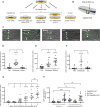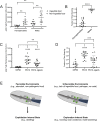Neuroendocrine gene expression coupling of interoceptive bacterial food cues to foraging behavior of C. elegans
- PMID: 38231572
- PMCID: PMC10945577
- DOI: 10.7554/eLife.91120
Neuroendocrine gene expression coupling of interoceptive bacterial food cues to foraging behavior of C. elegans
Abstract
Animal internal state is modulated by nutrient intake, resulting in behavioral responses to changing food conditions. The neural mechanisms by which internal states are generated and maintained are not well understood. Here, we show that in the nematode Caenorhabditis elegans, distinct cues from bacterial food - interoceptive signals from the ingestion of bacteria and gustatory molecules sensed from nearby bacteria - act antagonistically on the expression of the neuroendocrine TGF-beta ligand DAF-7 from the ASJ pair of sensory neurons to modulate foraging behavior. A positive-feedback loop dependent on the expression of daf-7 from the ASJ neurons acts to promote transitions between roaming and dwelling foraging states and influence the persistence of roaming states. SCD-2, the C. elegans ortholog of mammalian anaplastic lymphoma kinase (ALK), which has been implicated in the central control of metabolism of mammals, functions in the AIA interneurons to regulate foraging behavior and cell-non-autonomously control the expression of DAF-7 from the ASJ neurons. Our data establish how a dynamic neuroendocrine daf-7 expression feedback loop regulated by SCD-2 functions to couple sensing and ingestion of bacterial food to foraging behavior. We further suggest that this neuroendocrine feedback loop underlies previously characterized exploratory behaviors in C. elegans. Our data suggest that the expression of daf-7 from the ASJ neurons contributes to and is correlated with an internal state of 'unmet need' that regulates exploratory foraging behavior in response to bacterial cues in diverse physiological contexts.
Keywords: C. elegans; TGF-beta; gene expression; neuroendocrine signaling; neuroscience.
© 2023, Boor et al.
Conflict of interest statement
SB, JM, DK No competing interests declared
Figures





Update of
-
Neuroendocrine Gene Expression Coupling of Interoceptive Bacterial Food Cues to Foraging Behavior of C. elegans.bioRxiv [Preprint]. 2023 Nov 13:2023.07.15.549072. doi: 10.1101/2023.07.15.549072. bioRxiv. 2023. Update in: Elife. 2024 Jan 17;12:RP91120. doi: 10.7554/eLife.91120. PMID: 37503081 Free PMC article. Updated. Preprint.
Similar articles
-
Neuroendocrine Gene Expression Coupling of Interoceptive Bacterial Food Cues to Foraging Behavior of C. elegans.bioRxiv [Preprint]. 2023 Nov 13:2023.07.15.549072. doi: 10.1101/2023.07.15.549072. bioRxiv. 2023. Update in: Elife. 2024 Jan 17;12:RP91120. doi: 10.7554/eLife.91120. PMID: 37503081 Free PMC article. Updated. Preprint.
-
Sensory neurons couple arousal and foraging decisions in Caenorhabditis elegans.Elife. 2023 Dec 27;12:RP88657. doi: 10.7554/eLife.88657. Elife. 2023. PMID: 38149996 Free PMC article.
-
C. elegans Males Integrate Food Signals and Biological Sex to Modulate State-Dependent Chemosensation and Behavioral Prioritization.Curr Biol. 2020 Jul 20;30(14):2695-2706.e4. doi: 10.1016/j.cub.2020.05.006. Epub 2020 Jun 11. Curr Biol. 2020. PMID: 32531276 Free PMC article.
-
[Genetics and evolution of developmental plasticity in the nematode C. elegans: Environmental induction of the dauer stage].Biol Aujourdhui. 2020;214(1-2):45-53. doi: 10.1051/jbio/2020006. Epub 2020 Aug 10. Biol Aujourdhui. 2020. PMID: 32773029 Review. French.
-
Host-microbe interactions and the behavior of Caenorhabditis elegans.J Neurogenet. 2020 Sep-Dec;34(3-4):500-509. doi: 10.1080/01677063.2020.1802724. Epub 2020 Aug 12. J Neurogenet. 2020. PMID: 32781873 Free PMC article. Review.
Cited by
-
Genetic variants that modify neuroendocrine gene expression and foraging behavior of C. elegans.Sci Adv. 2024 Jun 14;10(24):eadk9481. doi: 10.1126/sciadv.adk9481. Epub 2024 Jun 12. Sci Adv. 2024. PMID: 38865452 Free PMC article.
-
Sources of behavioral variability in C. elegans: Sex differences, individuality, and internal states.Curr Opin Neurobiol. 2025 Apr;91:102984. doi: 10.1016/j.conb.2025.102984. Epub 2025 Feb 21. Curr Opin Neurobiol. 2025. PMID: 39986247 Free PMC article. Review.
-
C. elegans foraging as a model for understanding the neuronal basis of decision-making.Cell Mol Life Sci. 2024 Jun 8;81(1):252. doi: 10.1007/s00018-024-05223-1. Cell Mol Life Sci. 2024. PMID: 38849591 Free PMC article. Review.
-
Mitochondrial energy state controls AMPK-mediated foraging behavior in C. elegans.Sci Adv. 2024 Apr 19;10(16):eadm8815. doi: 10.1126/sciadv.adm8815. Epub 2024 Apr 17. Sci Adv. 2024. PMID: 38630817 Free PMC article.
References
-
- Boor S. Genetic Analysis of Bacterial Food Perception and Its Influence on Foraging Behavior in C. elegans. Cambridge, MA: Massachusetts Institute of Technology; 2022.
MeSH terms
Associated data
Grants and funding
LinkOut - more resources
Full Text Sources
Research Materials
Miscellaneous

